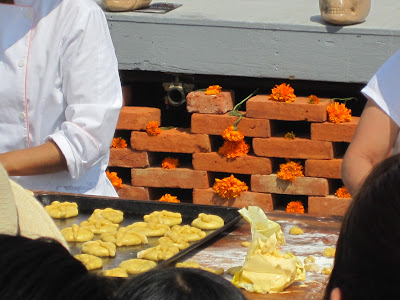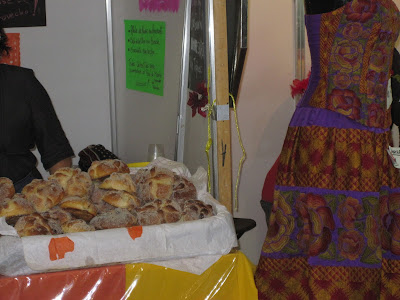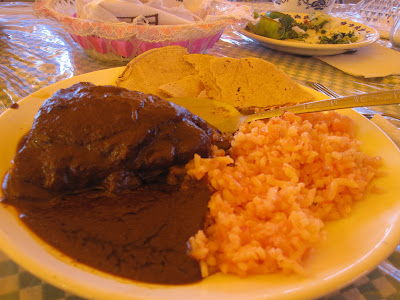
Mexico has other birthday traditions besides
mañanitas and
piñatas and
tres leches cake, though this one that I have to share today is much less pleasant. After the cake is brought out and the candles are blown out, the chants of "
Mordida, mordida" begin. Then, the birthday celebrator, with the help of someone nearby, goes head first into the cake for the first bite, covering their mouthal and nasal regions in frosting. No one escapes this tradition, not even my Mexican source's 91 year old
abuelita (she went on her own though; you can't push an old lady). The "
Beso, beso" chant commonly follows this, and the birthday celebrator must kiss a loved one nearby, thus sharing the frosting facial. Ridiculous photos must follow before you can actually go wash your face. (And, don't worry, the birthday celebrator has to eat the piece of cake that they put their face in.)
This weekend, Jonatan (my authentic Mexican source) had his birthday and, sadly, had to make his own cakes to celebrate (I at least bought the ingredients, but he's the experienced pastelero). In the last Tres Leches blog, I had a fancy and non-traditional chocolate cake, which was delicious, but authentic tres leches cakes are much more delicious and simpler. After about 15 tres leches filled birthday celebrations in the past year (big Mexican family), even the most common peach filled tres leches has grown on me. However, my personal favorite is the less common (due to the price) but still authentic pecan (or simply nuez, or nut) tres leches cake. I can't wait for the next birthday!
Ingredients
8 eggs
240g sugar
40g butter, melted but room temperature
240g flour
1 can of Lechera (sweetened, condensed milk)
1 can of Nestle Media Crema
1 can of Carnation evaporated milk
(note: we make 2 6-inch round cakes because the milk mixture is enough for two, and I have no idea what you could do with leftover tres leches.)
1 liter whipping cream
200g sugar
1 tsp. vanilla extract
1 large can of peaches in syrup
and
1 cup of pecans
Directions
1 - Preheat an oven to 350* F, and grease and flour 2 6-inch cake molds. Set aside.
2 - Mix the eggs and sugar in a stainless steel (or glass) bowl, and put the bowl over a bain marie (a shallow pan of water on low heat).
3 - Whisk constantly for 5 minutes, or until the mixture has tripled in volume. For the last minute, raise the flame to high heat.
4 - Remove from heat, and continue to whisk constantly until the mixture is room temperature, about 3 minutes.
5 - Gently fold the flour in to the egg mixture. Add the butter.
6 - Divide the mixture evenly into the 2 cake molds and put into the oven. Bake for about 20 minutes.
7 - While the cake is baking, mix the three cans of leches together. Stir well, and refrigerate until needed. Also, slice the peaches and toast and chop the pecans in preparation.
8 - Whip together the cream, sugar and vanilla until you have stiff peaks. Refrigerate until needed.
9 - When the cakes are done, remove them immediately from the mold, and cut them each into three layers.
10 - With a pastry brush, saturate the bottom layers, each with about 1/6 of the milk mixture. Then, put a layer of the whipped cream. Add pecan slices to one cake, and peach slices to the other.
11 - Put the next layer of cake on top. Repeat Step 10.
12 - Put the last layer of cake on top. Add the remaining milk mixture with the pastry brush.
13 - Frost the cake all around with the remaining whipped cream.
14 - Decorate with the very traditional designs shown in the picture, or however you feel like.
15 - Let the cake set up for at least an hour in the refrigerator (as long as you can stand the wait), and enjoy!
 Everybody knows that New York City is a traditionally magical place during Christmas. After three years of living in New York, the crowds, the cold and the cost can really get to you, and while I can't get rid of the crowds in Mexico City (it's the 2nd most populated city in the world), I can at least enjoy a plethora of free, government-sponsored events in the pleasant, temperate Mexico City winter weather.
Everybody knows that New York City is a traditionally magical place during Christmas. After three years of living in New York, the crowds, the cold and the cost can really get to you, and while I can't get rid of the crowds in Mexico City (it's the 2nd most populated city in the world), I can at least enjoy a plethora of free, government-sponsored events in the pleasant, temperate Mexico City winter weather.















































